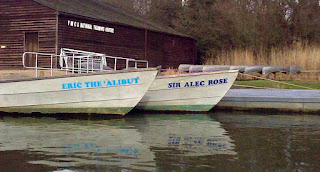Up the Hamble again today, with Home Built Boat Rally friends Chris Waite, Paul Hadley and Phil Oxborrow with dog Gem. Here is Paul at the oars of Octavia while Chris sits regally behind, directing.
Old Gaffer and blog reader Bernie turned up at the Swanwick hard to take a look at our boats, as he has bought the plans for a Selway Fisher 12ft Thames Skiff and needed to decide whether to make the beam 3ft 3in or to go for the 3ft 9in option. He has gone for 3ft 3in, wisely I think.
It was nice to meet you, Bernie, and I look forward to you joining us on future expeditions in your Thames Skiff!
Went to the Horse and Jockey at Curbridge and, joy, they were open, welcoming, and serving a brilliant breakfast consisting of a real proper sausage and lots of other stuff including bubble'n'squeak. And they had a new (to me, anyway) real ale from Gales called Seafarer, which is light, refreshing, suitbable for lunchtime quaffing when one has to drive home, and £3 a barrel goes to the maritime charity.So my curse on the H&J is hereby rescinded, repealed, revoked and rethingied.
Talking of charities, I passed the YMCA training centre and was pleased to note:
a) someone has a sense of humour;
b) they still remember the unassuming local man who went round the world without hype, hoopla or commercial sponsorship.


























